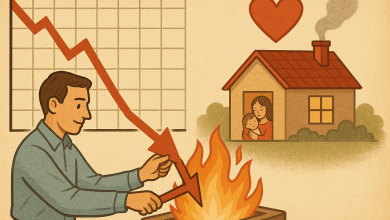My Bear Market Investment Game Plan: Adjusting the Strategy

Creating an investment game plan is a crucial part of building lasting wealth. Without one, you’re likely to accumulate far less over your lifetime. Now that the S&P 500 has corrected by 20% in 2025, we’ve officially entered another bear market. Historically, bear markets have lasted about two years on average, but this one is likely to be much shorter given it is self-inflicted.
One reason I pinned my post How I’d Invest $250,000 Cash Today is because I get this question constantly. The amount doesn’t have to be $250,000 in cash, but any amount of money. It’s my real-time roadmap and a way to stay consistent with both thought and action, especially during turbulent times.
After back-to-back 20%+ gains in the S&P 500 in 2023 and 2024, I didn’t want to give back too much of my 2021 gains like I did in 2022. Let’s revisit the investment game plan and see where I could have improved and what I’m adjusting now that the stock market has plummeted.
This isn’t investment advice for you, as we’re in different financial situations. It’s a look into how I’m thinking about managing my own money during a bear market. Please make your own investment decisions appropriate to your goals.
A Review Of My Investment Game Plan In A Bear Market
For background, I’ve been investing since 1996 and have lived through the 1997 Asian Financial Crisis, the 2000 dot-com bust and the 2008 global financial crisis—the latter with over $1.5 million invested. During the 2008 collapse, I lost 35%–40% of the net worth it took me a decade to build, all within six months. I never want to go through that experience again, especially now that I have a family to support.
Our #1 goal in a bear market: Remain DUPs, which stands for Dual Unemployed Parents, as opposed to DINKs or HENRYs. My wife and I share the goal of never having to work for anyone again. We can’t go back at our age. Right now, what we value most is having the time and energy to be with our kids (ages 8 and 5) before they leave home at 18.
We don’t want to come home exhausted after a long day of work. Instead of needing an escape from work and family on the weekends, we want to spend the entire weekend together. And during school breaks, we aim to travel as a family for longer stretches of time. As older parents, we already don’t have as much energy as the average younger parent.
As moderate-risk investors, this is our investment game plan to maintain our freedom using the investments and passive income we’ve already built. Given my wife and I don’t have steady paychecks, our main goal is to survive the bear market until better times return.
We cannot afford to lose more than 40% of our net worth at this stage of our lives. At the same time, we want to take advantage of investment opportunities. This is how we are deploying cash.
1) Treasury Bonds (30% of Cash Holdings -> Down To 20%)
With Treasury yields now around 4.45% from 5%, bonds are less attractive than before at 5%. Still, earning ~4.45% risk-free beats losing 20%+ in the stock market. So if you’ve looked down on Treasury bonds before, it’s time to reconsider. The goal isn’t to generate outsized returns—it’s to protect you from downside risk in more volatile assets.
If you are in a high marginal federal income tax bracket, Treasury bonds provide an additional boost since the interest earned is state-tax free. In a bear market, I always want to have at least six months of living expenses in cash. Not only does cash provide psychological comfort, it also enables you to invest in value opportunities.
Given the recent stock market correction, I’m reducing this bond deployment allocation from 30% to 20%.
2) Stocks (25% of Cash Holdings -> Up To 35%)
I was cautious entering 2025, with the S&P 500’s forward P/E around 22X—well above the historical average of 18X. After two blockbuster years, some mean reversion seemed inevitable.
At the time, I wrote: “Given expensive valuations, I’m only buying in $1,000–$5,000 tranches after every 0.5%–1% decline. The S&P 500 could go back down to 5,000 if valuations mean revert.” I stuck to that plan and started buying after a 3% dip… but now the index is down much more, with the S&P 500 falling to as low as -4,850 from an expected floor of 5,500.
Unfortunately, I was not cautious or patient enough. I’ve been buying the dip and the market keeps dipping. That said, I’ve been buying the dip for 26+ years, and over the long run, it’s worked out. It’s in the short term when it always feels the worst. This latest correction reaffirms why I prefer the steadier returns of real estate over the gut-wrenching volatility of stocks.
In light of the pullback, I’m upgrading my stock allocation from 25% to 35%. There now seems to be a decent probability the S&P 500 could correct to 4,500, or 2 multiples below the long-term forward P/E multiple average of 18. Why pay an average valuation multiple when the government is purposefully sacrificing the stock market for potentially lower rates?
3) Venture Capital (20% of Cash Holdings → Increasing to 25%)
Investing in venture capital has been a good move so far. I wanted exposure to private AI companies because I anticipate a challenging future for our children. I also value the ability to invest in companies I believe are performing well and poised to raise their next funding round at a higher valuation. This type of almost arbitrage and transparency is why I’m a fan of open-ended venture funds.
OpenAI recently closed a new $40 billion funding round, valuing the company at $300 billion—double its valuation less than 10 months ago. This kind of momentum bodes well for other private AI companies, which may also raise at higher valuations, though nothing is guaranteed.
In hindsight, I should have allocated more than just 20% to venture capital. Still, with public markets in turmoil, we’re seeing IPO delays (e.g., Klarna) and valuation compression. As a result, venture investors must stay disciplined and avoid overpaying.
Below is my Fundrise Venture Capital investment dashboard. Returns have been steady so far. Once I sell a rental property, I plan to increase my allocation.
For now, I’m upgrading my Venture Capital allocation to 25% from 20%. There is likely much more volatility under the surface. But mentally, it’s nice not to see it. Hopefully, there will be better valuations in the private markets given the forth has come out of the public markets. Fundrise is a long-time sponsor of Financial Samurai.

4) Real Estate (24.9% of Cash Holdings)
2025 is shaping up to be real estate’s time to shine and potentially outperform stocks by a wide margin. I’ve been waiting for this moment since 2022, after the Fed hiked rates 11 times in record time. Now, amidst all the uncertainty and chaos, expectations are back for three-to-five rate cuts in 2025, from zero-to-two cuts at the beginning of the year.
Pent-up demand, lower mortgage rates, and capital rotating out of funny money stocks and into tangible assets are setting the stage for continued strength in many real estate markets. That said, markets that boomed the most and have ample room to build new supply—like Austin, Dallas, Punta Gorda, and Cape Coral—are showing signs of weakness.
The gap between the S&P 500 index and U.S. single-family home prices is large and likely unsustainable. Real estate prices should catch up while the S&P 500 corrects. If the government is going to purposefully crash the stock market, then it should do everything it can to support the real estate market, where ~66% of Americans own homes.

Strong M&A In Real Estate Bodes Well
Here’s a major tell: Rocket Companies (owner of Rocket Mortgage, formerly Quicken Loans) just agreed to acquire mortgage servicing giant Mr. Cooper for $9.4 billion. This follows their $1.75 billion acquisition of Redfin. You don’t spend that kind of money unless you’re bullish on a real estate and mortgage rebound.
I’m comfortable with this 24.9% allocation to real estate because I’m already heavily exposed—about 50% of my net worth is tied to real estate. Earlier this year, I spoke with Ben Miller, CEO of Fundrise, and we both agreed that residential commercial real estate is one of the most attractive asset classes today due to its relatively low valuations.
When faced with the decision to invest in the S&P 500 trading at 22X forward earnings or in residential commercial real estate trading at 20–30% discounts from March 2022 highs, I chose the latter.

5) Financial Education (0.1% of Cash Holdings)
Since I allocated 0% to debt paydown because most of us refinanced our mortgages and (hopefully) don’t carry revolving credit card balances, the final category to bring my allocation to 100% is financial education.
I strongly believe that financial education is key to building lasting wealth. It’s why I majored in economics at William & Mary, earned my MBA from Berkeley, started Financial Samurai, and continue to write books. A foundational understanding of asset allocation, risk and return, tax strategy, and the various ways to grow wealth is incredibly valuable.
Unfortunately, most people don’t take the time to read articles—let alone books—about personal finance anymore. I saw this lack of careful reading with my latest April Fool’s Day post and the subsequent comments! As a result, they often get blindsided during bear markets.
I’ve witnessed this cycle of financial destruction repeatedly since I began working in finance in 1999. People over-allocate to risk assets or go on margin before a big collapse. Others panic sell near the bottom and hold cash for an unreasonably long time. Once you fall behind during a recession, it becomes extremely difficult to catch up to your peers.
Spending just 0.1% of $250,000—$250—on books like Buy This, Not That or Millionaire Milestones is negligible in the grand scheme. But the potential return on that investment can be thousands of percent.
Sadly, it often takes significant financial loss for people to finally take action. That was the case for me during the 2008–2009 Global Financial Crisis, which ultimately motivated me to launch Financial Samurai.

Please Develop Your Own Investment Game Plan
If you don’t develop an investment game plan, you’re likely to accumulate far less wealth than your peers who do. Worse, you might lose a significant amount of net worth due to improper risk exposure and allocation.
Establish your financial goals, then create a plan to get there. If you’re not sure where to start, consider working with a fee-only financial advisor or financial professional of some sort. Or, if you have the means and want more hands-on attention, a wealth manager could be an option. Just be prepared to pay up given they charge based on a percentage of assets.
To many people wing it when it comes to their personal finances. And in 10 years, those who do often wonder where all their money went.
Readers, how are you deploying your cash in this bear market? Are you adjusting your investment strategy? How much lower do you think the market will go, and why? Are you financially prepared for a 1-2 year downturn?
To expedite your journey to financial freedom, join over 60,000 others and subscribe to the free Financial Samurai newsletter. Financial Samurai is among the largest independently-owned personal finance websites, established in 2009. Everything is written based on firsthand experience.

